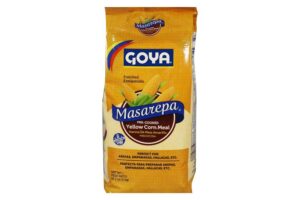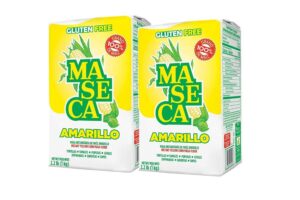Latin American dishes are known for their distinctive ingredients, and among the most popular are masa harina and masarepa. Both are made from corn kernels offering you a flavorful and chewy bite.

However, they have varying colors, textures, and flavors, making them ideal for distinctive dishes. Should you use masa harina or masarepa in your next dish? Let’s find out.
What Is Masa Harina?
Masa harina, meaning “dough flour” in Spanish, is a dough flour used to make many dishes in Latin America, especially in Mexico.
It is made through nixtamalization, which involves soaking corn kernels in an alkaline solution such as lime water and theme grinding them.
Nixtamalization is an ancient practice that dates back to the early ages. The process improves the nutritional value of the corn, allowing your body to absorb nutrients like calcium and niacin easily.
It also gives masa harina a distinctive flavor and texture.
What Is Masarepa?
Masarepa is a close cousin to masa harina popular in Latin American dishes. While both are derived from corn kernels, masarepa does not undergo the nixtamalization process.
This results in a low-nutrient dough with a milder flavor. Masarepa is closely associated with Colombian and Venezuelan dishes. It is used to make fried dough food known as arepas in most South American countries.
Masa harina vs Masarepa: Comparison Table
| Masa Harina | Masarepa | |
| Texture | Coarse (ideal for thicker tamales and tortillas) | Fine texture (ideal for making crispy arepas) |
| Flavor | Distinct, earthy corn with milder sweetness than tortilla | Neutral, sweeter corn |
| Composition | Nixtamalized corn flour that is dried | Pre-cooked yellow corn flour that hasn’t undergone nixtamalization |
| Uses | Sopes, tortillas, corn cakes, pupusas | Arepas, cheese rolls, cachapas |
| Availability | Available in most stores | Available in most stores |
| Nutritional value | High in niacin and calcium due to nixtamalization | Lower nutritional value |
| Color | Yellowish-white | White |
Masa Harina vs Masarepa: Texture

Masa harina has a coarse and gritty texture somewhat similar to corn flour but with a more granular feel. Creating a dough can be daunting and confusing as it tends to take a crumbly appearance.
But it is this texture that gives the dough a satisfying bite. It makes it a perfect option for making tortillas, tamales, and pupusas.
Thanks to the nixtamalization process, the dough mimics a texture similar to a rustic loaf of bread. With each bite, you get a soft yet chewy experience.
Masarepa on the other hand is fine and smooth – like finely ground corn. It allows you to make a silky-smooth dough ideal for arepas, cheese rolls, and cachapas. Unlike masa harina, which is coarse, masarepa is powdery and starchy.
Masa Harina vs Masarepa: Flavor
Masa harina has an earthy flavor thanks to the nixtamalization process. It unlocks the flavors in the corn, offering cornbread-like notes, which is reminiscent of warm soil and freshly harvested corn.
It also has nutty yet slightly sweet undertones, adding to its flavor. And thanks to nixtamalization with lime, you get hints of lime, which add complexity. The flavor shines in tortillas, tamales, and pupusas dishes.
Masarepa on the other hand has a neutral flavor. The corn-like flavor is milder and more subtle compared to tortillas. Since it skips the nixtamalization process, it offers a cleaner flavor, making it ideal for dishes with many ingredients.
The dominant flavor in masarepa is a gentle sweet corn taste that resembles fresh corn kernels. The slightly grainy undertones add a touch of rustic charm, awakening your taste buds. As you’d expect, masarepa has no lime hints.
Masa Harina vs Masarepa: Composition
As mentioned, masa harina goes through the nixtamalization process, which not only unlocks its nutritional value but also its chemical makeup.
The process releases calcium and niacin nutrients, making it an ideal option for those inclined to nutritious snacks. Nixtamalization also helps in the breakdown of proteins, making it easier for your body to digest and absorb them.
But that’s not all, nixtamalization also releases volatile compounds, offering an earthy,cornbread-like flavor. And thanks to the lime water, the corn’s outer shell is softened, resulting in hominy.
Masa harina has more fat content than masarepa thanks to the germ in the corn kernels.
As you know, masarepa skips the nixtamalization process, meaning much of the corn’s chemical makeup remains intact. As such, it has lower nutrient content as it retains less niacin and calcium compared to masa harina.
The protein structure also remains unaltered, making it less digestible for different people. And since there’s no hominy formation, masarepa has a finer texture than masa harina. It retains the corn’s hull.
Unlike masa harina, masarepa has more fiber content due to the corn’s hull. And when it comes to storage, masa harina might need preservatives while masarepa does not.
Masa Harina vs Masarepa: Uses

Thanks to its richness in nutrients and distinctive taste, masa harina shines in many Latin American dishes. You can use it to make tortillas such as crispy tostadas and soft flour tortillas.
It is also popular with tamales like Cuband and Mexican tamales. If you like the chewy pupusas dish, then masa harina is what you’ll need. It is also most ideal for preparing empanadas, enchiladas, and sopa azteca.
Masarepa on the other hand excels in a handful of recipes; the most common being arepas. The crispy griddle-cooked cornbread-like rounds showcase the flavor and texture of masarepa.
It also shines in cheese rolls, cachapas, and empanadas (Venezuelan).
If you crave versatility, consider using masa harina. However, if you want to enjoy arepas, masarepa is your go-to ingredient.
Masa Harina vs Masarepa: Availability
Masa harina is easier to find than masarepa. It will populate the Latin American aisle of most local grocery stores. You can also find it in most online stores at competitive prices. There are also many brands and sizes to choose from.
Masarepa is less common and primarily found in Latin American markets. As a targeted product, it has fewer brand options than masa harina. In addition, it fetches a higher price.
You can find it in most popular online stores such as Amazon.
Masa Harina vs Masarepa: Color
Color is yet another differentiating visual cue. Masa harina has a yellowish-white color thanks to the nixtamalization process.
It alters the corn kernels’ color resulting in a warmer hue. Different offer it in shades of yellow, ranging from pale to golden.
Masarepa, devoid of nixtamalization, is pure white. However, some brands sell yellowish options.
Final Verdict
Masa harina and masarepa are staple ingredients for several Latin American dishes. Made from corn kernels, they have a distinct flavor, texture, and color.
Masa harina has a sweet but complex flavor while masarepa has a sweeter flavor. Masarepa has a gritty and starchy texture while masa harina has a granular texture.
Luckily, both can be found in local and online stores and come in different colors and sizes.
